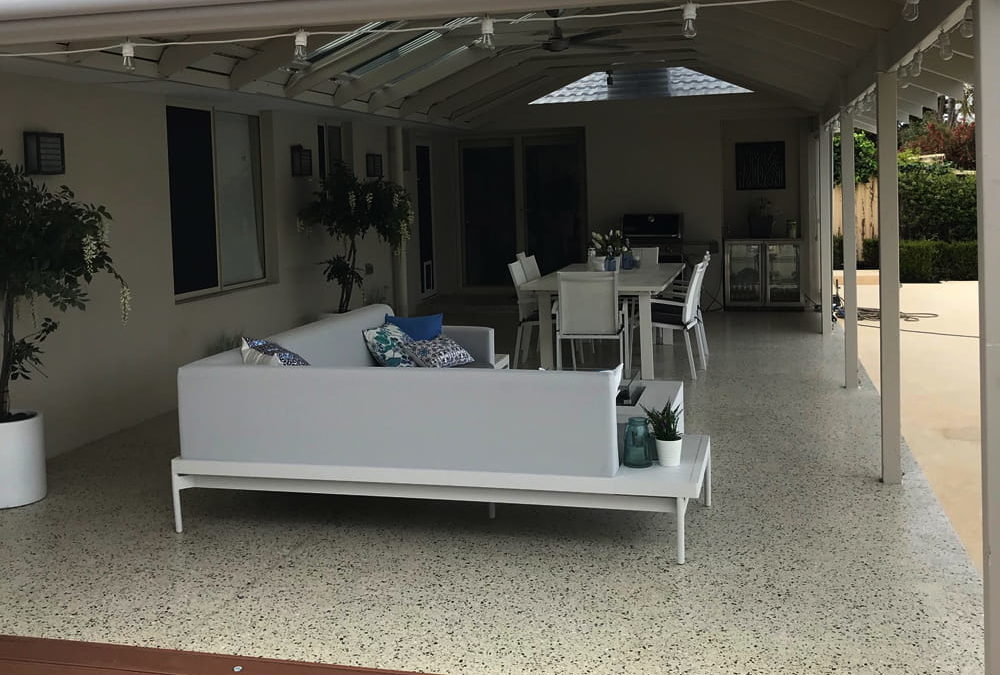Honed Concrete vs. Polished Concrete: What’s the Difference?

Why Use Honed Concrete and Epoxy Floors for Your Restaurant
June 30, 2020
Is Honed Concrete Suitable for Outdoor Use?
August 5, 2020When we hear the terms honed concrete and polished concrete, we often think of a smooth, shiny surface that’s used as a flooring solution. While they may sound the same, both materials have their own unique characteristics that make them different from one another. Most honed concrete flooring contractors use these terms interchangeably, thus creating confusion for the average homeowner. Both honed concrete and polished concrete undergo a mechanical process where the exterior surface is cut and/or refined to achieve the desired finish.
It is after the initial grinding phase we see the difference between these two flooring choices in terms of aesthetics, functionality, and overall suitability for a given application. Let’s talk about the distinct characteristics of honed concrete and polished concrete so you can choose the right flooring option for your household.
What is honed concrete?
Honed concrete (also known as grind and seal) is done by grinding the top of the concrete to reveal as little or as much aggregate on the surface. After the initial grinding phase is completed, a topical coating (sealant) is applied to the surface to protect it against contaminants and create either a matte or full-gloss finish. Honed concrete is an ideal flooring choice for pathways, porches, footpaths, and driveways because of its hard-wearing characteristics. Once the sealant dries up, it gets absorbed into the concrete and creates an impenetrable barrier that keeps dust, dirt, stains, and microorganisms from getting into the surface’s pores.
Because honed concrete uses a topical sealer, it will need to be sanded back and resealed every 3-7 years to maintain its appearance. Generally, honed concrete is more cost-effective than polished concrete if we’re talking about upfront costs. However, you need to factor in the resealing of honed concrete to ensure it lasts for decades.
The great thing about honed concrete is that you can customise its look depending on how you see fit. For example, if you want full aggregate exposure, the contractor will simply grind the surface down to reveal more stones and create a beautiful aesthetic appearance. Conversely, you can choose a nil exposure which reveals trace amounts of aggregate for a completely different look.
Honed concrete is great for surfaces that present slip hazards like pool surrounds and verandas. An anti-slip additive is mixed with the sealant to improve foot traction on wet conditions. This makes honed concrete a safer alternative to other flooring options like glazed ceramic tiles and laminates.
What is polished concrete?
Mechanically polished concrete (MPC) is often considered the more premium flooring option when compared to honed concrete. This is because polished concrete undergoes intensive mechanical refinement to create a shiny surface that looks and feels luxurious. With polished concrete, it’s the surface itself that shines and not a topical coating like the ones used in honed concrete.
The initial process is similar to honed concrete wherein the contractor grinds down the concrete to reveal as little or as much aggregate on the surface. But instead of applying a sealant afterwards, the concrete is grouted and undergoes several different processes to harden/densify the floor. Once that is completed, the surface is polished to achieve the desired sheen the client is looking for.
Like with honed concrete, polished concrete is highly customisable. You can choose from nil aggregate exposure all the way to full aggregate exposure as well as a matte or shiny finish. This makes polished concrete an excellent flooring option for indoor use which can add a touch of sophistication to any modern home. But because polished concrete is super shiny, it can get a bit slippery when wet, which is why it’s not recommended for outdoor flooring applications.
Choosing between honed concrete and polished concrete
Many consumers feel conflicted when choosing between honed concrete and polished concrete since both possess equally impressive qualities. At the end of the day, it all comes down to your own unique needs and applications. For outdoor flooring projects, we recommend using honed concrete due to its durability, affordability, and slip-resistance. If you want a luxurious indoor flooring that screams sophistication all around, then polished concrete is definitely a great choice.
The only considerations left are the cost and maintenance. Honed concrete generally costs less to install than honed concrete, but requires more upkeep down the line. Polished concrete, on the other hand, may cost you more upfront, but since you don’t need to worry about reapplying a sealant, the upkeep is quite minimal. Both flooring choices will last a lifetime if well-taken care of which means you’ll get great value out of your investment.
Honed concrete and polished concrete are some of the best flooring choices out there. They fit a wide range of applications, they look modern and updated, and they definitely boost the curb appeal of your property. Whichever one you choose, you’re bound to have a reliable flooring option that will serve you well for years to come. As always, we recommend contacting a reputable contractor to tackle your flooring needs so that the project is done timely and of high quality.





